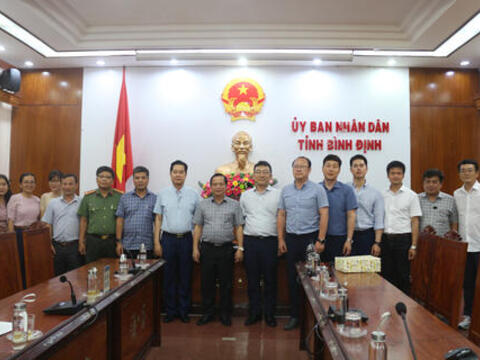Many models of marine environmental protection have been effective
Recently, departments, branches and authorities of coastal localities have synchronously deployed solutions for sustainable marine economic development. In particular, many activities and models of marine resource and environmental conservation; protection of aquatic resources in lagoons and coastal areas have been effective.
Protection of marine resources and environment
In May and June 2024, turtles repeatedly came to the beach of Nhon Hai commune (Quy Nhon city) to lay more than 400 eggs. Currently, a large number of turtle eggs have hatched, and have been protected and relocated to a safe place by the authorities, relevant organizations and local people. This is not the first time, because in 2021, Nhon Hai commune beach also had turtles come ashore to lay nearly 400 eggs; then they were protected and hatched with a hatching rate of more than 80%.
Notably, not only Nhon Hai beach, turtles also came to Cu Lao Xanh beach (Nhon Chau commune, Quy Nhon city) to nest and lay eggs in mid-July. This shows that the activities to protect sea turtles, coral reef ecosystems and protect the marine environment in Quy Nhon sea area carried out by the local community have brought positive signals.
Dr. Nguyen Viet Cuong, Head of the Department of Environmental Protection (Department of Natural Resources and Environment), said: "A clean marine environment, diverse marine ecosystems, and unthreatening living activities are suitable conditions for sea turtles and whales to regularly "dock" in the sea areas of Quy Nhon, De Gi, and Hoai Hai".
It is known that in recent years, Community Organizations (CBOs) in Nhon Hai, Nhon Ly, Nhon Chau communes, and Ghenh Rang ward (Quy Nhon city) have implemented many activities and achieved positive results in conserving and protecting sea turtles; protecting coral reefs and the environment in the sea areas assigned for management.
Mr. Nguyen Ton Xuan Sang, a member of the TCCĐ for the protection of coastal aquatic resources (NLTS) in Nhon Hai commune, said: The commune's TCCĐ consists of 50 members, operating on a voluntary basis. In addition to protecting sea turtles and coral reefs, members also regularly collect and collect waste in offshore areas and on the seabed to clean up the sea.
"The achievement we have achieved is that sea turtles continuously come to Nhon Hai commune beach to lay eggs and hatch successfully. This not only contributes to the conservation of precious species but also attracts tourists to promote the development of community tourism in coastal villages", Mr. Sang shared.
According to Mr. Nguyen Thanh Danh, Vice Chairman of Nhon Ly Commune People's Committee, the Commune People's Committee creates conditions and supports the commune's TCCĐ to carry out activities to protect coral reefs and co-manage coastal aquatic resources. Strengthen propaganda and mobilize the community to conserve and protect marine resources and ecological environment to serve the project of developing community tourism in the locality.
.jpg)
Members of the Nhon Hai Commune Fisheries Association collect and collect garbage offshore and on the seabed. Photo: Nhon Hai Commune Fisheries Association
Protecting NLTS and biodiversity
In recent times, the work of protecting NLTS along lagoons and coastal areas has also been actively implemented by the agricultural sector and local authorities of coastal areas. Co-management and TCCĐ models have been consolidated and improved, contributing to effectively protecting NLTS and conserving biodiversity in areas assigned to management by competent authorities.
Mr. Ho Ngoc Chanh, Vice Chairman of Phu My District People's Committee, said: In early 2024, the district recognized and assigned TCCĐ of communes along Tra O lagoon to co-manage, protect and exploit NLTS in this area. TCCĐ was established on a voluntary basis, including more than 190 members who are households and individuals in 4 communes of My Duc, My Chau, My Loi and My Thang.
TCCĐ regularly patrols and inspects to promptly prevent; requests competent state agencies to handle illegal fishing activities in Tra O lagoon area. This is a suitable direction, taking people as the core in developing NLTS, protecting biodiversity and creating sustainable livelihoods.
Sharing the same view, Mr. Pham Dung Luan, Vice Chairman of Phu Cat District People's Committee, said: Implementing the co-management model and TCCĐ, the fishing community actively works with local authorities to manage and protect NLTS. Timely detect, report to competent agencies to prevent, arrest and handle cases of using electric shocks, tightening machines, explosives to exploit aquatic and marine products in De Gi lagoon area.
Mr. Nguyen Van Nhung, Deputy Head of the Department of Sea and Islands (Department of Natural Resources and Environment), said: The Provincial Party Committee and Provincial People's Committee have issued many plans and action programs on sustainable development of the marine economy. In particular, the focus is on sustainable development of the marine economy on the basis of green growth; conservation of biodiversity and marine ecosystems.
In recent times, relevant departments, branches and local authorities of coastal areas have strengthened the conservation and protection of marine resources and environment. Typically, the project "Management and protection of coastal coral reef ecosystems associated with the development of community ecotourism in Nhon Ly, Nhon Hai, Nhon Chau communes and Ghenh Rang ward"; "Improving management capacity and environmental protection awareness of local communities, building a community model of collection, classification and treatment to reduce plastic waste in coastal communes and wards".
In addition, the model of "Collecting plastic waste from fishing vessels to shore" for 200 fishing vessels in the province; "Management of domestic solid waste and waste from the fisheries sector to promote circular economy in Quy Nhon city" has contributed significantly to the sustainable development of the marine economy.

 Tiếng Việt
Tiếng Việt 








